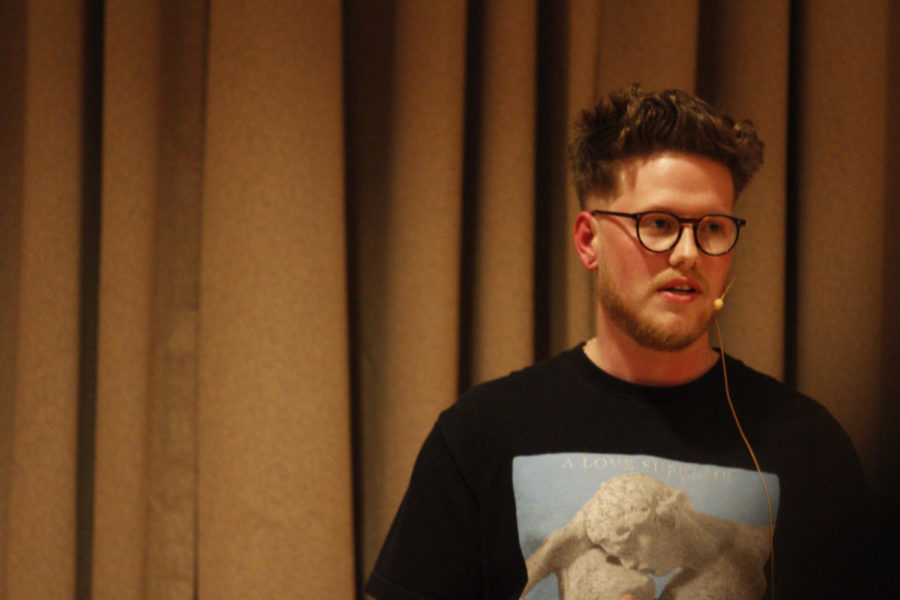Artist Paul Cooley speaks out about battling addiction with passion
Alexandra Kelly/Iowa State Daily
Cooley talking about being arrested for graffiti. On Thurs. 23, a lecture was held in the Sun Room of the Memorial Union titled ‘Addiction and Art’ where Paul Cooley shared his story. Cooley is a successful artist on the rise who has overcome drug addiction and homelessness to pursue his dreams.
February 23, 2017
Paul Cooley uses art as a coping mechanism for dealing with his emotions. But long before that, he coped by punching a kid in his elementary school and drinking at the age of 12.
Born and raised in New York City, Cooley started making paintings as a form of self-expression. In his younger years though, alcoholism and a wide variety of different drugs were all he centered his life around.
Cooley, who spoke Thursday at the Memorial Union about his life and artwork, said he started tagging the buildings of Queens, New York, with his name in middle school. At this time, he also happened to take up drinking and smoking marijuana, his first drug of choice.
“That was one of my first coping mechanisms to feel comfortable in his own skin,” Cooley said. “Because for whatever reason, I didn’t feel comfortable.”
Graffiti was the first time Cooley had “made a name for himself.” He recalled going to a party while he was in high school where he was recognized while painting his name on a wall.
“I knew then that my name preceded me,” Cooley said. “It was probably an ego thing, but it felt good.”
However, Cooley’s newfound outlets, both art and drug use, did not fair well for him. Vandalism is a felony in New York, and Cooley got arrested for using marijuana in public a fair number of times in high school.
In an attempt to save Cooley from being sent to a juvenile detention center, his parents enrolled him in a military boarding school in upstate New York, hoping to show the court that he was trying to straighten out his young life. While at boarding school, Cooley was sent to three years probation.
“I loved it; I found the bad kids right away,” he joked. “It was like going to college early.”
Although boarding school helped Cooley with his criminal record, it did not do much for his destructive habits. He got involved with what he compared to a drug ring within the school and took up a new substance — cocaine.
Cooley was expelled from the military school and sentenced to live in a group home by his probation officer.
“I was 17, and that was my first time not touching drugs or alcohol since the age of 12,” Cooley said.
Cooley said his first turning point was July 5, 2010, when he got into a motorcycle accident while under the influence of prescription pain killers. The accident could have easily killed him, but Cooley managed to walk away with nothing more than road burn on his arms.
“I told myself, it wasn’t [me] that was the problem, it was the pain killers that were the problem,” he said.
Since that day, Cooley has not touched drugs or alcohol, quitting cold turkey. He eventually stayed with an old friend who lived in Florida who was studying social work at the time.
She made him go to Narcotics Anonymous, a support group for drug addicts, which Cooley said was the first thing that actually started to work for him because he was with like-minded individuals.
“That was the only couch I had left to sleep on, so I changed because I had to,” Cooley said. “Not necessarily because I wanted to.”
In his recovery, Cooley has taken up odd jobs and started to educate himself about business management. He “went with the flow” of whatever came his way, ranging from email marketing for a friend to tattooing out of his apartment.
Whenever Cooley had downtime, he started to begin to draw again. Eventually he moved back to New York City and began to graffiti the whole city with a picture of a man with a moustache. He put his art on Instagram, leading to his first commissioned work for $600.
His hobby eventually turned into a career, and he is now a professional artist and speaks about the importance of being positive and working hard for one’s passions.
Today, his paintings rival those of well-known artists such as Banksy, selling for thousands of dollars.
Mwape Mwanakatwe, graduate student in horticulture, said she appreciates how Cooley includes his own personal experiences in his art.
“I’ve thought about selling my own art, but then I think, like, ‘Who does that?,’” Mwanakatwe said. “But he talked about being authentic, courageous and authentic. So now it made me think more about ‘why not?’”
This is not the first time Cooley’s work has impacted Iowa State. Students in the College of Design had chosen one of Cooley’s paintings, titled “Personal Growth,” to be included in Iowa State’s Art on Campus Collection in 2016.
“I’m not where I’ll be yet, but I’m here,” Cooley said. “I have an incredible life. It’s crazy. If I died right now, I would be so happy.”
















